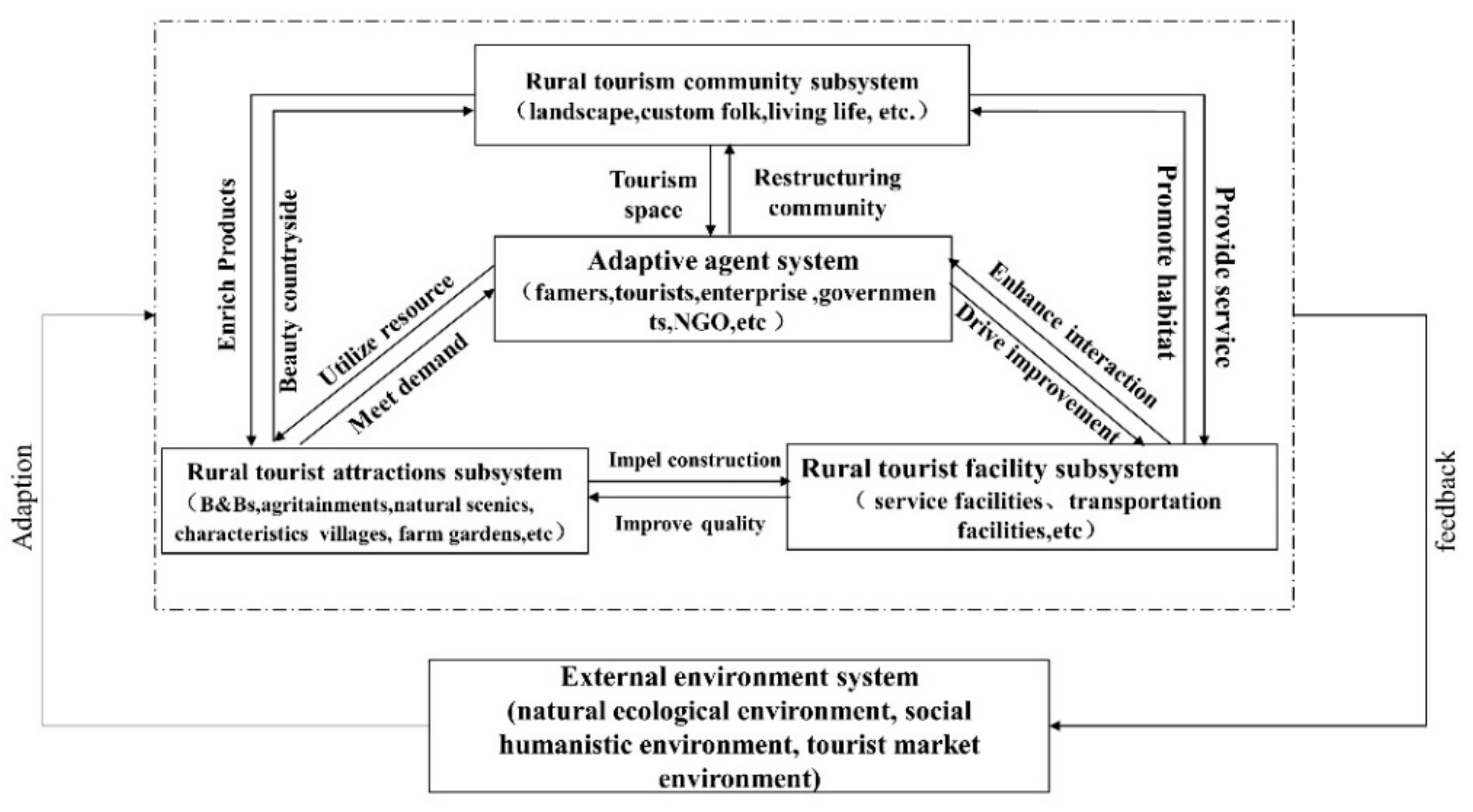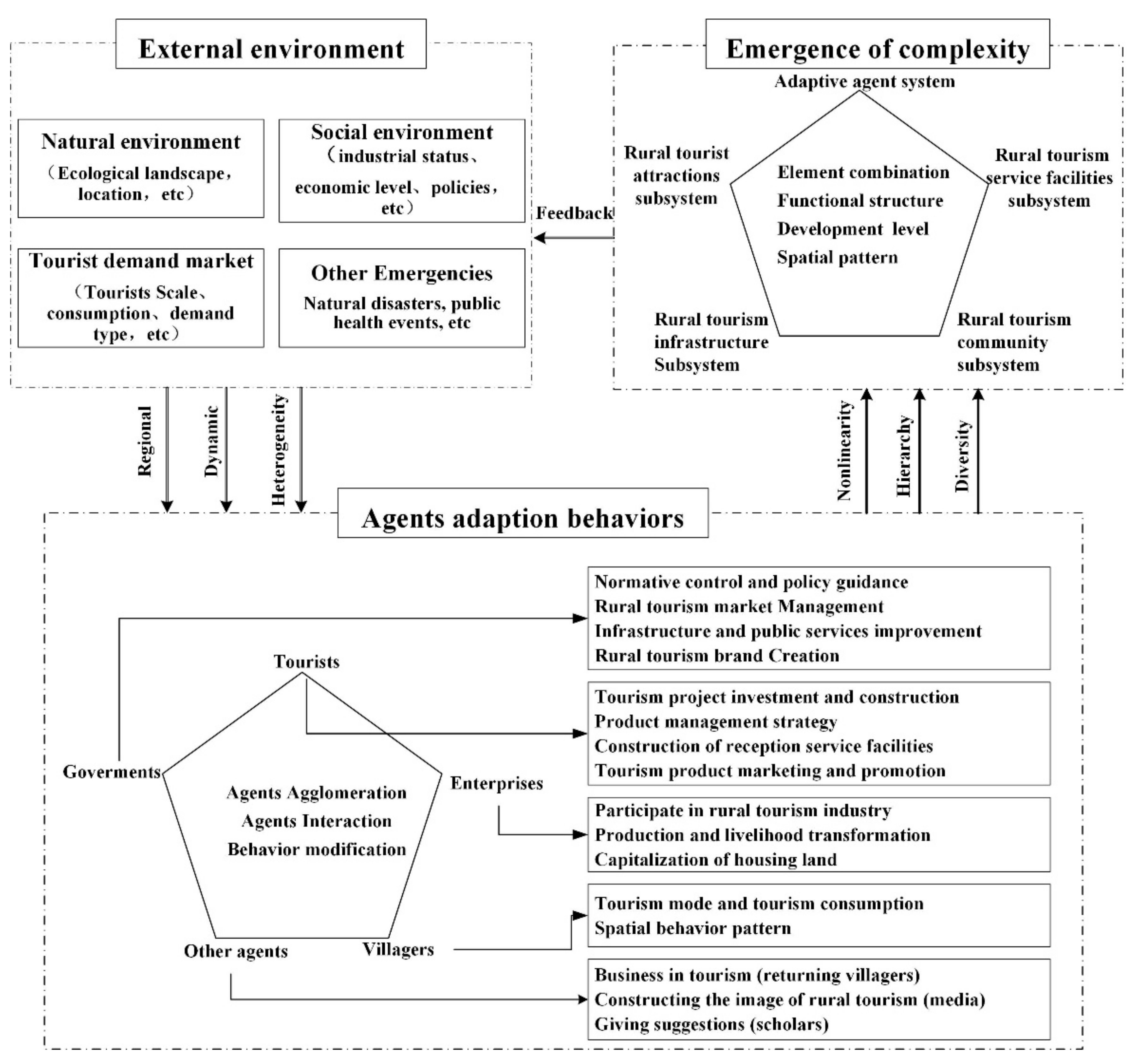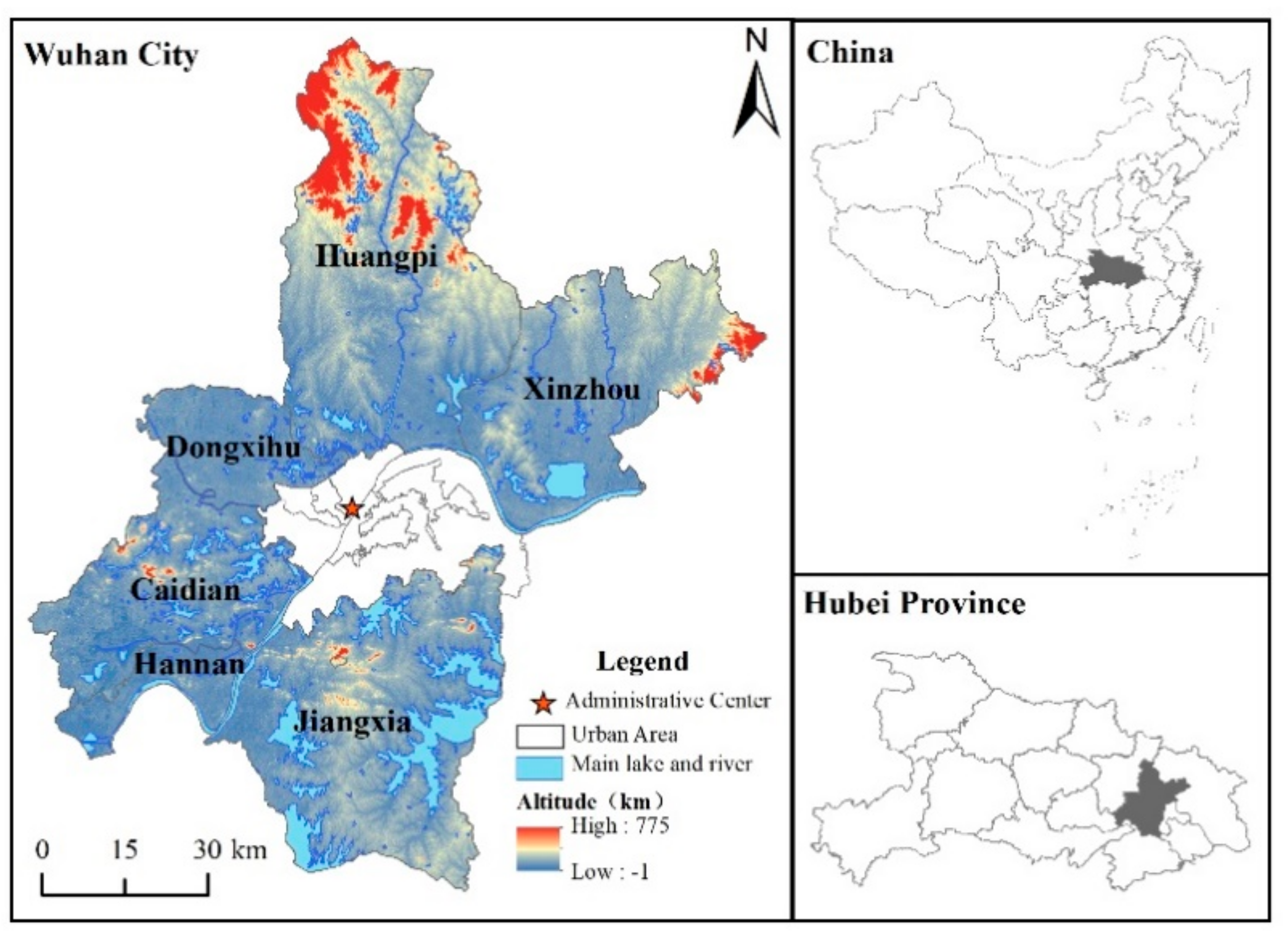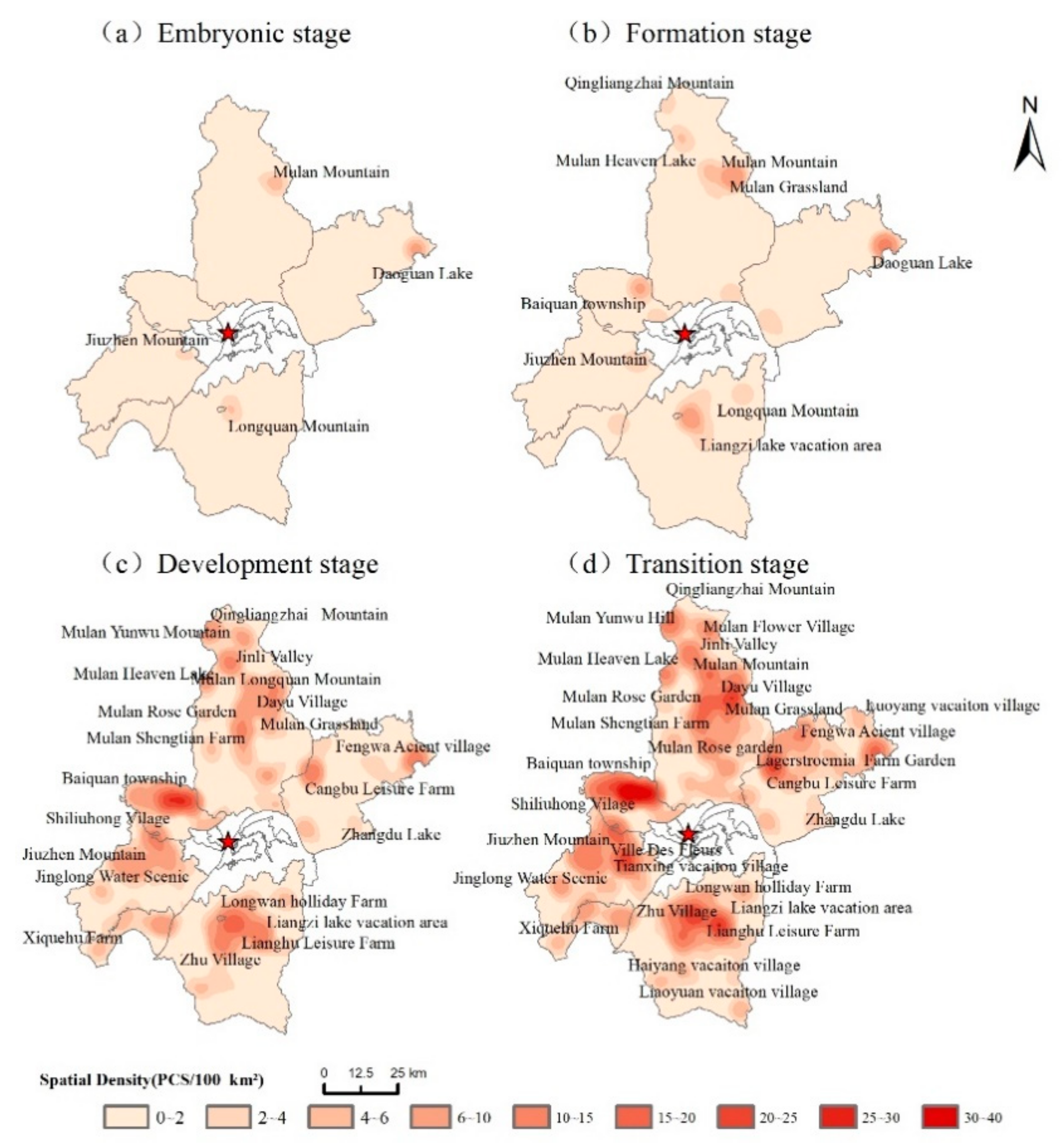The Evolution of Rural Tourism in Wuhan: Complexity and Adaptability
Abstract
:1. Introduction
2. Theoretical Analysis Framework
2.1. Overview of Complex Adaptive Systems Theory
2.2. Composition and Characteristics of the Rural Tourism Complex Adaptation System
2.3. Complex Adaptive Mechanism of Evolution of Rural Tourism
3. Case Location and Data Sources
3.1. Case Location
3.2. Data Sources
4. Evolutionary Process and Spatial Pattern of Rural Tourism Destination System in Wuhan
4.1. Effects of Multiple Agents’ Behaviors and Rural Tourism System Development in Wuhan
4.1.1. Embryonic Stage of the Rural Tourism System (before 2000)
4.1.2. System Formation Stage of the Rural Tourism System (2001–2007)
4.1.3. Rapid Development Stage of the Rural Tourism System (2008–2015)
4.1.4. Consolidation and Transformation Stage of the Rural Tourism System (from 2016 to Now)
4.2. Co-Evolution of the Rural Tourism Destination System in Wuhan
5. Conclusions and Discussion
5.1. Conclusions
5.2. Discussion
5.2.1. Theoretical Implications
5.2.2. Managerial Implications
5.2.3. Limitations and Future Research Prospects
Author Contributions
Funding
Institutional Review Board Statement
Informed Consent Statement
Data Availability Statement
Acknowledgments
Conflicts of Interest
References
- Rosalina, P.D.; Dupre, K.; Wang, Y. Rural Tourism: A Systematic Literature Review on Definitions and Challenges. J. Hosp. Tour. Manag. 2021, 47, 134–149. [Google Scholar] [CrossRef]
- Huang, Z.F.; Lu, L.; Su, Q.; Zhang, J.; Sun, J.; Wan, X.; Jin, C. Research and Development of Rural Tourism under the Background of New Urbanization: Theoretical Reflection and Breakthrough of Predicament. Geogr. Res. 2015, 34, 1409–1421. [Google Scholar]
- Su, B. Rural Tourism in China. Tour. Manag. 2011, 32, 1438–1441. [Google Scholar] [CrossRef]
- Lu, L.; Ren, Y.S.; Zhu, D.C. The Research Framework and Prospect of Rural Revitalization Led by Rural Tourism. Geogr. Res. 2019, 38, 102–118. [Google Scholar]
- Yang, J.; Yang, R.X.; Chen, M.H.; Su, C.H.J.; Zhi, Y.; Xi, J. Effects of Rural Revitalization on Rural Tourism. J. Hosp. Tour. Manag. 2021, 47, 35–45. [Google Scholar] [CrossRef]
- Tao, Y.X. An Empirical Study of the Demand Mechanism and Appeals-Alienation of Rural Tourism. Tour. Trib. 2015, 30, 37–48. [Google Scholar]
- Kim, S.; Jamal, T. The Co-Evolution of Rural Tourism and Sustainable Rural Development in Hongdong, Korea: Complexity, Conflict and Local Response. J. Sustain. Tour. 2015, 23, 1363–1385. [Google Scholar] [CrossRef]
- Chen, J.; Yang, X.J.; Wen, X.; Deng, M. The Theoretical Framework and Demonstration of Rural Adaptive Evolution in the Context of Tourism Development. J. Nat. Resour. 2020, 23, 1363–1385. [Google Scholar]
- Lu, L.; Zhang, Q.Y.; Huan, J.F.; Ren, Y.S. A Theoretical Research and Prospect of Tourism Destination Evolution Based on a Glocalization Perspective. Acta Geogr. Sin. 2021, 76, 1504–1520. [Google Scholar]
- Leiper, N. The Framework of Tourism. Ann. Tour. Res. 1979, 64, 390–407. [Google Scholar] [CrossRef]
- Butler, R.W. The Concept of a Tourist Area Cycle of Evolution Implications for Management of Resources. Can. Geogr. 1980, 24, 5–12. [Google Scholar] [CrossRef]
- Ma, M.; Hassink, R. An Evolutionary Perspective on Tourism Area Development. Ann. Tour. Res. 2013, 41, 89–109. [Google Scholar] [CrossRef]
- Faulkner, B.; Russell, R. Chaos and Complexity in Tourism: In Search of a New Perspective. Pac. Tour. Rev. 1997, 1, 93–102. [Google Scholar]
- Baggio, R. Oriental and Occidental Approaches to Complex Tourism Systems. Tour. Plan. Dev. 2013, 10, 217–227. [Google Scholar] [CrossRef]
- Speakman, M. A Paradigm for the Twenty-First Century or Metaphorical Nonsense? The Enigma of Complexity Theory and Tourism Research. Tour. Plan. Dev. 2017, 14, 282–296. [Google Scholar] [CrossRef]
- Baggio, R. Symptoms of Complexity in a Tourism System. Tour. Anal. 2008, 13, 1–20. [Google Scholar] [CrossRef] [Green Version]
- Mckercher, B. A Chaos Approach to Tourism. Tour. Manag. 1999, 20, 425–434. [Google Scholar] [CrossRef]
- McDonald, J.R. Complexity Science: An Alternative World View for Understanding Sustainable Tourism Development. J. Sustain. Tour. 2009, 17, 455–471. [Google Scholar] [CrossRef]
- Russell, R.; Faulkner, B. Entrepreneurship, Chaos and the Tourism Area Lifecycle. Ann. Tour. Res. 2004, 31, 556–579. [Google Scholar] [CrossRef]
- Speakman, M.; Díaz Garay, A. Perspectives on Tourism Development Planning in Acapulco: Conventional Methods and Complexity Theory. Int. J. Tour. Sci. 2016, 16, 203–221. [Google Scholar] [CrossRef]
- Zhang, S.L.; Zou, Z.J. Tourism Planning Synthetic Integrated Methodology Dealing with the Open Complicated and Large System. Hum. Geogr. 2001, 16, 11–15. [Google Scholar]
- Hartman, S. Towards Adaptive Tourism Areas? A Complexity Perspective to Examine the Conditions for Adaptive Capacity. J. Sustain. Tour. 2016, 24, 299–314. [Google Scholar] [CrossRef]
- Iandolo, F.; Fulco, I.; Bassano, C.; D’Amore, R. Managing a Tourism Destination as a Viable Complex System. The Case of Arbatax Park. Land Use Policy 2019, 84, 21–30. [Google Scholar] [CrossRef]
- Harris, D.L. Echo Implemented: A Model for Complex Adaptive Systems Computer Experimentation; Office of Scientific & Technical Information Technical Reports, University of North Texas: Denton, TX, USA, 2001. [Google Scholar]
- Lu, L.; Bao, J. The Course and Mechanism of Evolution about Qiandao Lake:Based on the Theory of Dissipative Structure. Acta Geogr. Sin. 2010, 65, 755–768. [Google Scholar]
- Ying, X. On the Regional Implosion of Tourist Flows: From Self -Organization to Organization. Tour. Trib. 2006, 26, 47–54. [Google Scholar]
- Baggio, R.; Scott, N.; Cooper, C. Network Science. A Review Focused on Tourism. Ann. Tour. Res. 2010, 37, 802–827. [Google Scholar] [CrossRef]
- Yang, Z.Y.; Yin, M.; Xu, J.G.; Lin, W. Spatial Evolution Model of Tourist Destinations Based on Complex Adaptive System Theory:A Case Study of Southern Anhui, China. J. Geogr. Sci. 2019, 29, 1411–1423. [Google Scholar] [CrossRef] [Green Version]
- Sessa, L. The Science of Systems for Tourism Development. Ann. Tour. Res. 1988, 2, 219–235. [Google Scholar] [CrossRef]
- Yang, C.Y.; Huang, Z.F.; Mao, W.D. On the Schools, Courses and Prospect of Complex System Evolution Theory in Tourism Areas. Hum. Geogr. 2009, 24, 66–70. [Google Scholar]
- Yang, C.Y.; Huang, Z.F.; Mao, W.D. Research on Fundamental Issues of Tourism Region Complex System Evolution Theory. China Popul. Resour. Environ. 2009, 19, 123–130. [Google Scholar]
- Holland, J. Emergence from Chaos to Order; Basic Books: New York, NY, USA, 1999. [Google Scholar]
- Holland, J. Hidden Order: How Adaptation Builds Complexity; Basic Books: New York, NY, USA, 1996. [Google Scholar]
- Stevenson, N.; Airey, D.; Miller, G. Complexity Theory and Tourism Policy Research. Int. J. Tour. Policy 2009, 2, 206–220. [Google Scholar] [CrossRef] [Green Version]
- Chen, Y. Complex Adaptive System Theory and Its Application: Foundation, Contents and Implication. J. Syst. Dialectics 2001, 9, 35–39. [Google Scholar]
- Li, B.H.; Zeng, R.Q.; Liu, P.L. Human Settlement Evolution of Traditional Village Based on Theory of Complex Adaptive System: A Case Study of Zhangguying Village. Geogr. Res. 2018, 37, 1982–1996. [Google Scholar]
- Zheng, W. Research Progress and Development Trend in Urban Economic Network Study Based on Complexity Theory. Prog. Geogr. 2015, 34, 376–686. [Google Scholar]
- Shi, Y.J.; Zhai, G.F.; Xu, L.H.; Zhou, S.T.; Lu, Y.W.; Liu, H.B.; Huang, W. Assessment Methods of Urban System Resilience: From the Perspective of Complex Adaptive System Theory. Cities 2021, 112, 103141. [Google Scholar] [CrossRef]
- Zhu, A.H.; Wu, Y.P. Understanding Complexity Adaptive System and Enterprise Management Studying. Sci. Manag. Res. 2003, 23, 63–66. [Google Scholar]
- Jin, H.; Yi, R.; Wang, Y.M.; Zhou, H.B. Toward a Complex Adaptive System: The Case of the Zhongguancun Entrepreneurship Ecosystem. J. Bus. Res. 2021, 128, 537–550. [Google Scholar] [CrossRef]
- Hu, W.J.; Chen, Y. Study on the Evolvement Route of Innovation Cluster Based on CAS Methodology. Complex Syst. Complex. Sci. 2008, 5, 22–27. [Google Scholar]
- Zeng, Z.X.; Zhang, Y.F.; Li, M. Research on Collaborative Governance Mechanism of Supply Chain Social Responsibility Based on CAS Theory. J. Syst. Sci. 2020, 28, 71–77. [Google Scholar]
- Choi, T.Y.; Dooley, K.J.; Rungtusanatham, M. Supply Networks and Complex Adaptive Systems: Control versus Emergence. J. Oper. Manag. 2001, 19, 351–366. [Google Scholar] [CrossRef]
- Phillips, M.A.; Ritala, P. A Complex Adaptive Systems Agenda for Ecosystem Research Methodology. Technol. Forecast. Soc. Chang. 2019, 148. [Google Scholar] [CrossRef]
- Bone, C. A Complex Adaptive Systems Perspective of Forest Policy in China. Technol. Forecast. Soc. Chang. 2016, 112, 138–144. [Google Scholar] [CrossRef]
- Zhang, L.; Wu, Y. The Formatting Mechanism of Tourism Cluster Based on CAS Theory: Taking Mice Tourism Cluster in Guangzhou as a Case. Econ. Geogr. 2013, 33, 171–176. [Google Scholar]
- Baggio, R. The Science of Complexity in the Tourism Domain: A Perspective Article. Tour. Rev. 2019, 75, 16–19. [Google Scholar] [CrossRef]
- Yang, C.Y.; Huang, Z.F.; Mao, W.D. A Preliminary Discussion about the Evolutionary Mechanism of Tourism Destinations Based on System Science. Tour. Trib. 2009, 24, 55–62. [Google Scholar]
- Shu, X.L.; Gao, Y.B.; Zhang, Y.X. Study on the Coupling Relationship and Coordinative Development between Tourism Industry and Eco-Civilization City. China Popul. Resour. Environ. 2015, 25, 82–90. [Google Scholar]
- Huang, J.; Lu, L. The Paradigm Transformation of Space in Tourism Destination from Perspective of Production of Space: A New Paradigm of Space Based on Emergence of Space. Sci. Geogr. Sin. 2015, 35, 47–55. [Google Scholar]
- Deng, A. Research on the In-Depth Expansion of the Rural Leisure Tourism Product System in Wuhan. Agric. Econ. Issues 2011, 10, 66–70. [Google Scholar]
- Wei, C.; Ge, D.; Long, H. The Tourism-Led Rural Transformation Development Mode in the Metropolitan Fringe Region: The Case of Wuhan City. Econ. Geogr. 2018, 38, 211–217. [Google Scholar]
- Panzer-Krause, S. The Lost Rural Idyll? Tourists’ Attitudes towards Sustainability and Their Influence on the Production of Rural Space at a Rural Tourism Hotspot in Northern Ireland. J. Rural Stud. 2020, 80, 235–243. [Google Scholar] [CrossRef]
- Sheng, Y.; Liu, Q. The Evolution of Human-Land Relationship in the Transmutation Process of Rural Tourism in Traditional Villages in Suburban Cities: A Case Study of Xunlonghe Village. Tour. Trib. 2021, 36, 95–108. [Google Scholar]
- Garrod, B.; Wornell, R.; Youell, R. Re-Conceptualizing Rural Resources as Countryside Capital: The Case of Rural Tourism. J. Rural Stud. 2006, 22, 117–128. [Google Scholar] [CrossRef]
- Janssen, M.A.; Schoon, M.L.; Ke, W.; Börner, K. Scholarly Networks on Resilience, Vulnerability and Adaptation within the Human Dimensions of Global Environmental Change. Glob. Environ. Chang. 2006, 16, 240–252. [Google Scholar] [CrossRef] [Green Version]
- Wu, M.-Y.; Wu, X.; Li, Q.-C.; Tong, Y. Community Citizenship Behavior in Rural Tourism Destinations: Scale Development and Validation. Tour. Manag. 2022, 89, 104457. [Google Scholar] [CrossRef]






| Element | Characteristic Interpretation | Compatibility Interpretation of Rural Tourism System |
|---|---|---|
| Aggregation | Aggregation of agents can form meta-agents, and meta-agents are reaggregated to form meta-meta-agents. The hierarchical organization of CAS is formed, producing complex phenomena. | Rural agents are aggregated to different scales, types, and levels of rural meta-agents such as tourism spots, tourism facilities, and tourism communities, which constitute the rural tourism system as subsystems. |
| Tagging | Different hierarchical systems have multiple tags, which can not only promote the “adhesion” of agents but also be used for the “reproduction” of agents. | Tourism image, core attractions, major projects, key policies, etc., can all constitute tags, which promote the derivation, differentiation, and gathering of villagers, citizens, enterprises, and tourists. |
| Flow | Many nodes and connectors form a resource flow network, and the cycle of resources has a multiplier effect. | Rural tourism destination system agents are connected with each other and the external environment through passenger flows, information flows, material flows, and capital flows. |
| Nonlinearity | The interaction between agents and environment is nonlinear and promotes the complex transition of the system. | The rural system evolutionary process shows complex evolutionary characteristics such as fluctuation, mutation, and emergence, and new system agents, elements, structural functions, and spatial patterns are apparent. |
| Diversity | Each new adaptation of agents opens up a new ecological niche, promotes further interaction, and thus brings about the emergence of diversified systems. | The continuous succession of external environment, tourism demand, tourism supply, and participants promote the formation of rural tourism with different modes, scales, and functions. |
| Internal model | Based on experience and learning ability, the agents bitterly adapt to the perpetual novelty environment and transform the adaptation behaviors into an internal model to guide the next adaptation. There are tacit and overt models. | In rural tourism, the tacit model is the choice of villagers’ livelihood strategy, enterprise management strategy, government planning, and control, while the overt model is the tourism product type and the spatial pattern of rural tourism. |
| Building blocks | Blocks are coupled according to spatial location and interactive action to build the hierarchy and complexity of the system. The higher-level rules are derived from the lower-level building blocks. | Rural tourism subsystems and elements constitute the building blocks of high-hierarchy systems. The formation and development, combination and dissolution, and competition and cooperation of rural tourism “blocks” reflect the evolutionary process of rural tourism. |
| Year | National 3A Scenic Spot | National 4A Scenic Spot | National 5A Scenic Spot | Provincial Leisure Agriculture Demonstration Spot | Provincial Tourism Village | National Culture Relic Protection site | Municipal Three-Star Homestay | Municipal RV Campground |
|---|---|---|---|---|---|---|---|---|
| 2000 | 1 | 0 | 0 | 0 | 0 | 1 | 0 | 0 |
| 2007 | 1 | 0 | 4 | 5 | 2 | 16 | 0 | 0 |
| 2015 | 11 | 6 | 4 | 5 | 7 | 30 | 0 | 0 |
| 2020 | 14 | 14 | 4 | 19 | 10 | 3 | 44 | 11 |
| Agent | Adaptive Behaviors |
|---|---|
| Government | In 1995, the “Ninth Five-Year Plan” put forward the development plan of building several holiday resorts around the city. |
| Enterprise | Enterprises and institutions built resorts around lakes and mountains. |
| Visitor | Some travel companies operated and launched one-day tour routes. |
| Agent | Adaptive Behaviors |
|---|---|
| Government | The Wuhan Tourism Master Plan and Mulan Eco-tourism Area Plan were issued and implemented. “Quality Classification and Evaluation of Leisure Farmhouses” was formulated. Rural tourism associations, tourism websites, and government departments were established. The “ring-radial shaped“ network road were built. In 2005, the “Home Construction Action Plan” was launched to renovate the country environment. |
| Enterprise | Since 2002, “Mulan series scenic spots” in Huangpi District have been opened one after another. |
| Resident | Residents set up hotels, agritainments. |
| Visitor | Increase in tourist scale. |
| Agent | Adaptive Behaviors |
|---|---|
| Government | Since 2008, Opinions on Accelerating Rural Land Circulation and Agricultural Scale Management, Developing Farmhouse Tourism have been issued. In 2012, “Wuhan Flower Tour Development Plan” established Wuhan as a “new flower city” and built six pastoral landscape flower viewing areas; In 2014, the “Mulan Culture Ecological Zone”, a national 5A scenic spot, was built; the Mulan legend was approved as a national intangible cultural heritage. The tourism road network was further improved; a Wuhan scenic spot annual card was issued. |
| Enterprise | Scenic spots such as Yunwu Mountain, Jinli Valley, Yao Mountain, and Houguan Lake were built, and Jiuzhen Mountain, Dayu Bay Village, and Qingliang Village were rated as national 4A tourism spots. Lianghu Farm, Jinlong Water Village, Tulip Park, Mulan Rose Garden, Crape Myrtle Urban Garden, etc. were opened one after another. |
| Resident | More villagers began to consciously carry out tourism business activities and resorts, family farmhouses, agritainment, and produce sales increased significantly. Farmers transferred the idle land to agricultural companies and tourism cooperatives, etc. |
| Visitor | The scale of passenger flows increased significantly, and self-driving tours and rural vacations had become the mainstream. Tourists looked forward to the “authentic” rural landscape and lifestyle. |
| Tourism Village Type | Typical Village | Main Attractions | Main Tourism Activities | Agents Participation |
|---|---|---|---|---|
| Whole village tourism type | Shiliuhong Village | Shiliuhong village | Settlement landscape, agritainment, picking fruits and vegetables, and renting land. | Government-led, villagers-based, enterprise participation. |
| Scenic driving type | Guantian Village | Mulan Great Lake | Ecological sightseeing, leisure and entertainment, agritainment, Mulan culture. | Enterprise-led, government-supported, villagers’ participation. |
| Rural elite driving type | Qunyi Village | Lianghu farmstead | Rural sightseeing, leisure and entertainment, fruit and vegetable picking, agritainment. | Enterprise-led, villagers’ participation, government-based. |
| Enterprise driving type | Xihu Village | Ji’nong Farm supermarket | Rural sightseeing, leisure and entertainment, fruit and vegetable picking, agritainment. | Enterprise-led, villagers’ participation, government-based. |
| Agent | Adaptive Behaviors |
|---|---|
| Government | Since 2016, Wuhan City has opened the construction of beautiful countryside demonstration villages. In 2017, the three projects of “citizens going to the countryside, rural elite returning home, and enterprises prospering the countryside” were implemented. In 2018, the “Three-year Action Plan for Wuhan Comprehensive Tourism (2018–2021)” and “Wuhan Rural Revitalization Strategic Plan (2018–2022)” were formulated, and the construction of the “Flower Tour” project was continued. From 2018 to 2020, rural tourism festivals were held for three consecutive years, rural tourist spots were promoted; now, coupons that allow people to benefit from tourism will be distributed, and many measures will be introduced to promote recovery after the epidemic. The Fourth Ring Road around Wuhan is open to traffic; Circular tourism highways and regional tourism greenways have been constructed. |
| Enterprise | Social capital has entered the countryside to build rural tourism resorts, agricultural sightseeing parks, and village B&Bs. The action of “state-owned enterprises joining villages” has been carried out and the political and industrial advantages of state-owned enterprises have been transformed into the kinetic energy and efficiency of rural tourism industry development. |
| Resident | The number of rural land and houses transferred to enterprises or cooperatives has increased significantly. Beautification of the village micro-landscape environment and the addition of the leisure and ornamental functions of agritainment; More citizens and outgoing rural talents have carried out tourism business activities and evolved into bionic villagers. |
| Visitor | Short-distance travel is in demand; The desire to return to the field is strong, and the forms of vacation, health tourism, and parent-child tourism are prominent. Attention has been paid to the emotional appeal of “homesickness” under an aesthetic artistic conception. |
| Project | Village | Main Model | Opening Time | Transfer Land from Villages |
|---|---|---|---|---|
| Husiguo township | Haiyang village | Vacation homestay and leisure agriculture | 2019 | 3200 acre |
| Flower expo township | Tianxing village | Vacation homestay and 4A scenic spot | 2017 | 1800 mu |
| Mulan flower park | Dutang village | Vacation homestay and 4A scenic spot | 2017 | 7000 mu |
| Fengxiang holiday village | Liaoyuan village | Vacation homestay and leisure agriculture | 2020 | 6000 mu |
| Yunjia slow village | Qunyi village | Vacation homestay and leisure agriculture | 2020 | 4000 mu |
| Huazhao valley township | Luo Yang village | Vacation homestay and leisure agriculture | 2017 | 3500 mu |
| Elements | Embryonic Stage | Formation Stage | Development Stage | Consolidation and Transformation Stage | |
|---|---|---|---|---|---|
| Dominant external environment | Abundant ecological resource endowment | Golden Week holiday; Increased economic level; Rural tourism demand for nature | Ecological civilization construction; High rural tourism demand | Internal needs for rural revitalization; Post-modern tourism; Post-epidemic period | |
| Agents adaptive behavior | Government | Tourism planning | Formulate tourism industry standards and improve road infrastructure | Rural tourism planning; Encourage tourism development; Land policies reform | Beautiful Countryside Construction; Rural revitalization planning; Three Township Engineering (Three Township Engineering: Citizens go to the countryside; Capable people return countryside; Township enterprises construct countryside); Recovery of rural tourism |
| Enterprise | Construct healthcare hotel for employees | Construct ecological sightseeing spot | Construct agricultural park, leisure, and entertainment scenic spots | Construct agricultural park, leisure and entertainment scenic spots, rural resort area | |
| Villager | Less involved in rural tourism | More involved in rural tourism | More involved in rural tourism; Grant of idle land | More involved in rural tourism; Grant of idle land and house | |
| Tourist | Few | Increasing | Rapidly increasing | Steadily increasing | |
| Returning villager | Few | Run agritainment activities | Lease land; Run the agritainment activities and tourism farm | Lease land and house; Run the agritainment, homestay, tourism farm | |
| Association | — — | Few | Increasing | Increasing | |
| Citizen | — — | — — | — | Run a homestay; Hold art activities | |
| Rural tourism system | Tourism product | Few; Mainly conference tourism products | Slowly increasing; Mainly ecological tourism products | Rapidly increasing, Mainly agricultural leisure tourism products | Steady increase; Diverse tourism products |
| Service facility | Few farmhouses | Few farmhouses and budget hotels | More farmhouses and budget hotels | More resort hotels and boutique homestays | |
| Infrastructure | Mainly urban roads | Mainly tourism roads | Mainly tourism roads, rural trunk roads | Mainly tourism roads, rural internal roads | |
| Spatial pattern | Scattered distribution | Multi-core cluster distribution | Multi-sector network distribution | Comprehensive tourism distribution | |
Publisher’s Note: MDPI stays neutral with regard to jurisdictional claims in published maps and institutional affiliations. |
© 2021 by the authors. Licensee MDPI, Basel, Switzerland. This article is an open access article distributed under the terms and conditions of the Creative Commons Attribution (CC BY) license (https://creativecommons.org/licenses/by/4.0/).
Share and Cite
Lv, L.; Hu, J.; Xu, X.; Tian, X. The Evolution of Rural Tourism in Wuhan: Complexity and Adaptability. Sustainability 2021, 13, 13534. https://doi.org/10.3390/su132413534
Lv L, Hu J, Xu X, Tian X. The Evolution of Rural Tourism in Wuhan: Complexity and Adaptability. Sustainability. 2021; 13(24):13534. https://doi.org/10.3390/su132413534
Chicago/Turabian StyleLv, Li, Jing Hu, Xin Xu, and Xiaobo Tian. 2021. "The Evolution of Rural Tourism in Wuhan: Complexity and Adaptability" Sustainability 13, no. 24: 13534. https://doi.org/10.3390/su132413534
APA StyleLv, L., Hu, J., Xu, X., & Tian, X. (2021). The Evolution of Rural Tourism in Wuhan: Complexity and Adaptability. Sustainability, 13(24), 13534. https://doi.org/10.3390/su132413534





